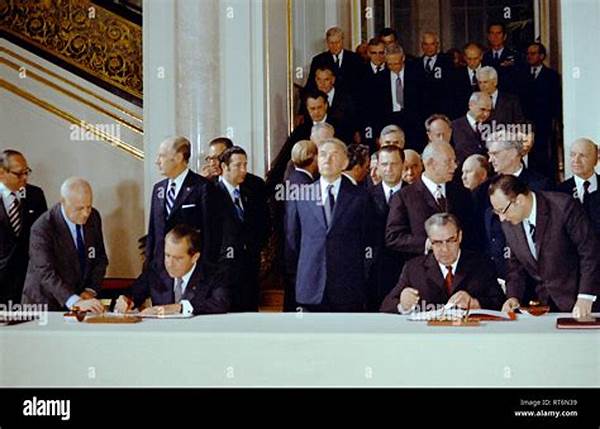The concept of strategic offensive arms limitations encompasses international efforts aimed at controlling and reducing the proliferation of long-range weapons capable of mass destruction. These efforts involve complex negotiations between global powers, with the primary objective of maintaining international security and stability. Strategic offensive arms limitations are integral to fostering an environment of mutual trust and cooperation, where nations agree to constraints on their arsenals, which in turn, diminishes the likelihood of nuclear and conventional arms races. Throughout the years, numerous treaties have been established to implement and regulate these limitations, setting precedents for ongoing and future disarmament dialogues.
Historical Context of Strategic Offensive Arms Limitations
Strategic offensive arms limitations can be traced back to the Cold War era, where rising tensions between superpowers necessitated diplomatic engagement to prevent catastrophic conflict. Discussions during this period led to notable treaties such as the Strategic Arms Limitation Talks (SALT) and Strategic Arms Reduction Treaty (START). These agreements marked significant milestones, as they not only promoted transparency and verification but also initiated a systematic reduction of nuclear arsenals. Strategic offensive arms limitations played a crucial role in de-escalating hostilities and setting a foundation for contemporary arms control measures. These efforts continue to evolve, adapting to the changing dynamics of global military capabilities and political relationships.
Key Principles of Strategic Offensive Arms Limitations
1. Deterrence and Stability
Strategic offensive arms limitations aim to maintain global strategic stability, deterring aggressive actions through balanced arsenals.
2. Transparency and Confidence-Building
Such limitations foster trust through transparency, enhancing cooperation, and reducing uncertainties in international relations.
3. Verification Mechanisms
Implementing robust verification mechanisms ensures compliance with arms control agreements, a cornerstone of effective strategic offensive arms limitations.
4. Reduction of Arsenals
By actively promoting the reduction of nuclear and conventional weapons arsenals, these limitations contribute significantly to global peace and security.
5. Non-Proliferation Enhancements
Strategic offensive arms limitations bolster global non-proliferation efforts, discouraging the spread of weapons of mass destruction to non-nuclear states.
Current Challenges in Implementing Strategic Offensive Arms Limitations
The modern landscape presents new challenges for strategic offensive arms limitations, driven by emerging technologies, geopolitical tensions, and fluctuating alliances. Cyber warfare, hypersonic missile development, and artificial intelligence have added complexities to traditional frameworks, necessitating updated approaches to arms control. Nations must navigate these challenges through innovative diplomatic strategies, which may include expanding multilateral treaties and incorporating new weapon categories into existing agreements. Adequate collaboration is essential, as it ensures that strategic offensive arms limitations remain relevant and effective in addressing contemporary security concerns.
Factors Influencing Strategic Offensive Arms Limitations
Several factors influence the success of strategic offensive arms limitations. Political will and diplomatic engagement are critical, requiring consistent dialogue and commitment from participating nations. Economic considerations may also play a role, as the immense costs associated with maintaining large arsenals promote interest in arms reduction. Furthermore, public opinion and advocacy from non-governmental organizations contribute to shaping policies and prioritizing disarmament efforts. These factors collectively impact the trajectory and effectiveness of strategic offensive arms limitations, underscoring the need for a multifaceted approach.
Regional Impacts of Strategic Offensive Arms Limitations
The implementation of strategic offensive arms limitations has region-specific impacts, shaping security environments and influencing local power dynamics. In regions with historical conflicts or ongoing tensions, these limitations can provide a framework for peaceful resolution and enhanced security cooperation. They also serve as deterrents against regional arms races by establishing norms and responsibilities among neighboring countries. Ultimately, strategic offensive arms limitations contribute to regional stability, paving the way for peace-building initiatives and confidence-building measures.
Future Prospects of Strategic Offensive Arms Limitations
Looking ahead, strategic offensive arms limitations must adapt to the rapidly changing international landscape. As new weapons systems emerge and strategic alliances shift, the role of diplomacy becomes even more critical in ensuring sustainable arms control. Future prospects include expanding the scope of existing agreements to include new technologies, strengthening international institutions tasked with oversight, and promoting inclusive participation from a broader array of nations. The continued relevance of strategic offensive arms limitations will hinge on the ability of global leaders to forge constructive pathways toward disarmament amid complex global challenges.
Conclusion on Strategic Offensive Arms Limitations
In conclusion, strategic offensive arms limitations remain a vital component of international security architecture. By reducing the potential for military escalation and fostering trust among nations, these measures play a pivotal role in maintaining global peace. Their success requires ongoing diplomatic efforts, flexible frameworks adaptable to emerging challenges, and a commitment to multilateralism. As the world continues to face uncertainties and evolving threats, the importance of strategic offensive arms limitations cannot be overstated. They represent a collective endeavor to avert conflict and promote a more secure and stable global order.





